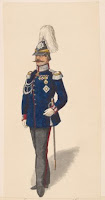I'll be running my Joust for The Fun of It game in our club's upcoming Saturday Game Day later this month. I'll be putting on the big knight version, with the Schleich Knights and associated accessories. This game presents special challenges given the over-sized figures, the way that they are posed, and the size and number of customized bits I fabricated for the game. Being retired, I'd like to take this particular game on the road to several US conventions in the upcoming year, so I'm using this opportunity to put together a dedicated system to efficiently and safely transport, set up, and take down the game. With conventions in the US consisting of participation games, it is not unusual for your table to be occupied in the time slots prior to and after yours. Convention organizers do allow time for setup and take down, but it can still get quite hectic to get ready, particularly if the game ahead of yours runs over, and equally so in the aftermath of your own game as you visit with players while trying to pack up and clear the table (and things never seem to fit back in the way they came out). So in this blog post, I will share my solution to this challenge. As usual, you may clix pix for BIG PIX in this post. I started off by getting a pack of 24" long letter sized banker's boxes. These are an elongated version of the standard banker's box.
I then put 2" Pluck Foam sheets into the boxes (two 12" x 12" sheets fit into each)... ...and then plucked (as the name suggests) squares of foam to create a custom space for each fig. Given the size of the figures and the length of the lances, the figures fit in puzzle like: The first box was fairly simple, but the second box turned out to be much more involved. The idea of specialized foam slots for figs is not a new idea, of course. It's quite common among fantasy/sci gamers in particular for some of their more high end/high priced models (many of which are quite large). I managed to get all 24 of my knights into two boxes. I managed to configure the heralds, characters, flags, and stands in a single box. The reviewing stand (included in the above right image) nests over the heralds.
I put together a separate "logistics" box (above left) which contains all the non figure stuff that goes on the table (the score board, the lists, the team trays, the list signs, etc). This way, I pull things from each box in turn while setting up as opposed to having to go between boxes. I also put together a "game master" tub (above right). This has all the stuff to actually run/play the game (the rules, reference sheets, ploy cards, tracking mats and markers, dice, pencils, clip boards, etc, etc).
The devil is in the details, of course, with customized storage. You want to not only be able to easily tell which box is which when setting up, but the real challenge comes when you try to put things back--particularly under a time constraint. Not only do you need to get the right figure into the right box, but also into the right spot in the "puzzle." To help with this, I came up with a one-brain-cell solution that anyone can follow: I put a picture of the contents on the box lid.
Above: the complete game system compartmented into four bankers boxes and one tub--a fairly compact and easily transported configuration for such a large layout. The figures and foam are not heavy, so those boxes are an easy lift. The game master tub has a bit of heft, but is easily managed. Most of all, when I want to hit the road, all I have to do is load things into their pre-designated spots and go. The only thing not included are the three game mats that I use (one under each list). These are Fat Mats (Grassy Field); each comes with a handy carrying case, so they fit quite nicely into this portability scheme.
Some may think this is all a bit "over the top." But my experience has been that this kind of work done up front allows me to focus on other things once I'm at the convention. I also generally prefer to run convention games as opposed to playing in them, so I consider time invested in systems to set up and run games as much a part of the hobby as painting figures.














Clever, useful, well done!
ReplyDeleteIf only the same could be said of more of my schemes 😀
DeleteA splendid bit of packing Ed…
ReplyDeleteYes taking a picture of where everything goes is always a good idea.
All the best. Aly
Eye candy aside, the use of digital photography and home publishing as tools (like this) really has transformed the hobby.
DeleteTaking the photo as a reference is a clever way of recording correct placement Ed!
ReplyDeleteI was thinking of all sorts of more artful and time consuming ways of marking the spaces inside and labelling the outside of the boxes, but I realized (duh!) that the pictures would do both!
DeleteExcellent ideas. Especially taking the photo. I couldn't tell how many things I've unpacked then just can't seem to get into the again. Elegant solution.
ReplyDeleteSame hard experience with the mysterious physics of miniatures transport has informed this solution. For other games, I also take photos of the final playtest table at home to expedite set up on site.
DeleteSmart move with the photo and good overall solution, failure to prepare, prepare to fail could not be levelled at you!
ReplyDeleteBest Iain
Thanks, Iain: I prefer that my failures be of the more spectacular sort, the kind that arise despite all preparations :)
Delete